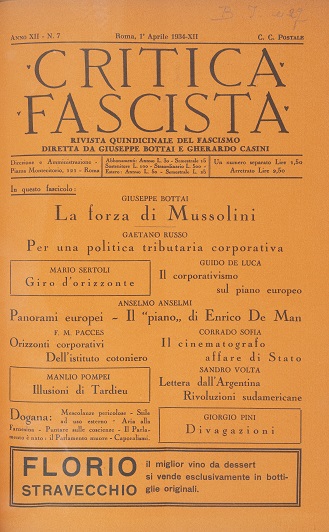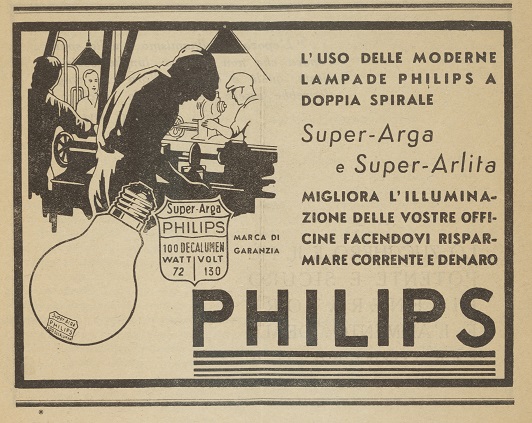The Critica Fascista magazine
Fascist Press
The entire twentieth century saw the proliferation of magazines as places of discussion between intellectuals, writers, philosophers, and politicians, with the ability of provoking and proposing new forms of literature. Each magazine is a reflection of the society that produced it, expressing its ideas and debates. Amongst the fascist magazines, Critica Fascista was the most revered, and a ruling one for several reasons: the first being its ambivalent founder and editor, Giuseppe Bottai; the second its cultural testimony on fascism, taking a sort of leftist stand within the regime that showed openness towards international culture; ultimately, its countercurrent aspects.

Critica Fascista in the Fascist Press
Critica Fascista was part of the propagandist print that characterised fascist Italy. Soon enough it became one of the most important magazines from the standpoint of the era’s political and cultural debates. Many critics have considered Bottai a moderate, or even outright critical, fascist. The critical approach to fascism encountered in the magazine fuels this opinion, but it can be explained in part by his cultural and intellectual class. Even though he ‘betrayed’ Mussolini and lived the rest of his life trying to redeem himself for his intransigence during the fascist era, Bottai remained one of the primary and most active proponents of fascist totalitarianism. Critica Fascista not only promoted fascist totalitarianism but also served as a ‘saviour’ and ‘the one who says the last word’ in debates regarding fascism. Bottai aimed to create new technical and cultural elites, so with the help of his collaborators and through the magazine he urged for a total modernization of ‘all things Italian’.
The fascist regime undertook the path for the formation of a uniform press and new journalism, which, like the government, had to be authentically fascist. While Mussolini tried to some degree to engage, in primis, in a ‘moderate approach’, this later shifted to a centralization of the press that left little to no independence for the journalists. A ‘cleansing’ action was put in motion, to finalise the project of bending the Italian press and journalists to comply to fascism entirely. In September 1928, Mussolini’s Office Press published a code of conduct for the press. Its goal was to silence specific news, while pretending to improve the morality of Italian society. The press became the quintessential medium for fascist propaganda, and monopolised the debate, promoting the compliance of collective thought with the regime.
Daily newspapers were the most outspoken in their support, while periodicals were less explicit, allowing implicit and ambiguous thoughts to be put into print. The target audience of the periodicals — particularly those of a socio-political nature — were young people of the fascist party and university students. Their purpose was to manipulate and distort the discussion on fascism, with the ultimate aim to involve the audience in the epos of Italian fascism. To achieve this, the audience had to feel and see thoroughly the image of the Duce, his dominance, and the fascist doctrine through images, print, and intellectual periodicals all turning to the same point. The fascist functionaries knew that the participation of the masses reached its pinnacle during the Duce’s speech on the balcony of Palazzo Venezia in Rome. Therefore, the primary concern was to get the press to recreate the same emotional state as in that moment.
Critica Fascista: A (Leftist) Fascist Periodical
Critica Fascista was a biweekly magazine/review journal founded on June 15, 1923, the first year of the Mussolini regime, by a 28-year-old Bottai. In 1925, the magazine noted as its founder, besides Bottai himself, a Jewish merchant from Milan, Gino Modigliani, who covered printing expenses. It remained in print until 1943, the final year of Mussolini’s dictatorship. In fact, the eighteenth and last issue came out on July 15, 1943, a few days before the fall of the fascist government. Bottai acted as the magazine’s editor and director throughout its existence. In his own words the birth of the magazine was ‘inspired by an urge to action’. It was meant to allude to Critica Sociale, a left-wing/socialist newspaper founded in 1891, and still in print today.
As Critica Fascista was a specifically political magazine, it was not intended for a greater audience. Editions rarely surpassed 5,000 copies. However, during the twenty years of its existence, it managed to cover all the cultural aspects of the fascist regime. Collaborations were also open to unorthodox fascists and to those who did not subscribe to the party. As a result, the entire magazine as a whole is of exceptional cultural and socio-political interest, with contributions by both internal and external collaborators. Despite the limited number of copies, Critica Fascista remained a highly popular and influential magazine.

There is something curious about the name of the magazine: ‘critica’ (criticism) and ‘fascista’ (fascist). According to Bottai, who was well aware that many people saw this as contradictory, the unusual pairing of ‘criticism’ with ‘fascist’ somehow implies the up-to-date following of the political changes, leaving space for the intellectuals to debate and support the fascist revolution. During the first years of the magazine’s existence there was a tendency to normalise fascism and to fight off provincial racism. At this time, Bottai was rather hostile towards the intransigence of fascism. In Critica Fascista, he also opposed the fascist hostility towards foreign literature. His criticism came from a cautious and critical attitude towards the party and its leader, which started when Bottai adhered to The National Fascist Party (PNF). The initiatives in the cultural sector were mostly unsuccessful, not because Bottai did not have Mussolini’s favour, but because they went against the mainstream fascist views and their execution altogether. Bottai aimed for an educated fascism, refined, based on classical studies, and open to both Italian and foreign literature and politics. His idea of fascism was essentially critical in the end because he advocated for a comeback to the original, ‘pure’ fascism, as he believed that the Fascist Revolution was incomplete and potentially even faulty.
The magazine's editorial, unless otherwise instructed, was generally attributed to Bottai, although it seems that other editors had contributed to the editorials. Notably, Bottai’s name is omitted as director and owner of the magazine from November 15, 1926, because he was nominated Subsecretary of State for the Corporations.
The collection of Critica Fascista in the Bibliotheca Italiana is still owned by the Groningen Committee of the Società Dante Alighieri , but it has been leased to the University Library since the 1950s. It covers only three out of twenty years of the magazine’s publications, from January 1, 1934, to January 1, 1937. However, for the year 1935 issues 9 and 14-19 are missing. The periodical’s front and back cover are tangerine orange as well as the pages dedicated to commercial ads. The general pages inside each copy are white. During this period, the people involved in the magazine were Giuseppe Bottai (director); Gherando Casini (co-director until November 1936); Filippo Franceschi (chief editor from 1936); Nicola de Pirro (chief editor until November 1936); Giorgio Berlutti (manager); and Riccardo Ferrari (chief administrator from August 1926). The place of print and typography is Editrice Il Lavoro Fascista (from 1933) and Tipografia del Senato del dot. G. Bardi (from 1936).
The registered address for the Direction and Administration of Critica Fascista was Piazza Montecitorio, 121, Rome. Giuseppe Bottai and Gherardo Casini are listed as its directors. From Issue No 1, November 1, 1936, the name of the former no longer appears, as he ceased to be co-director of the periodical.

